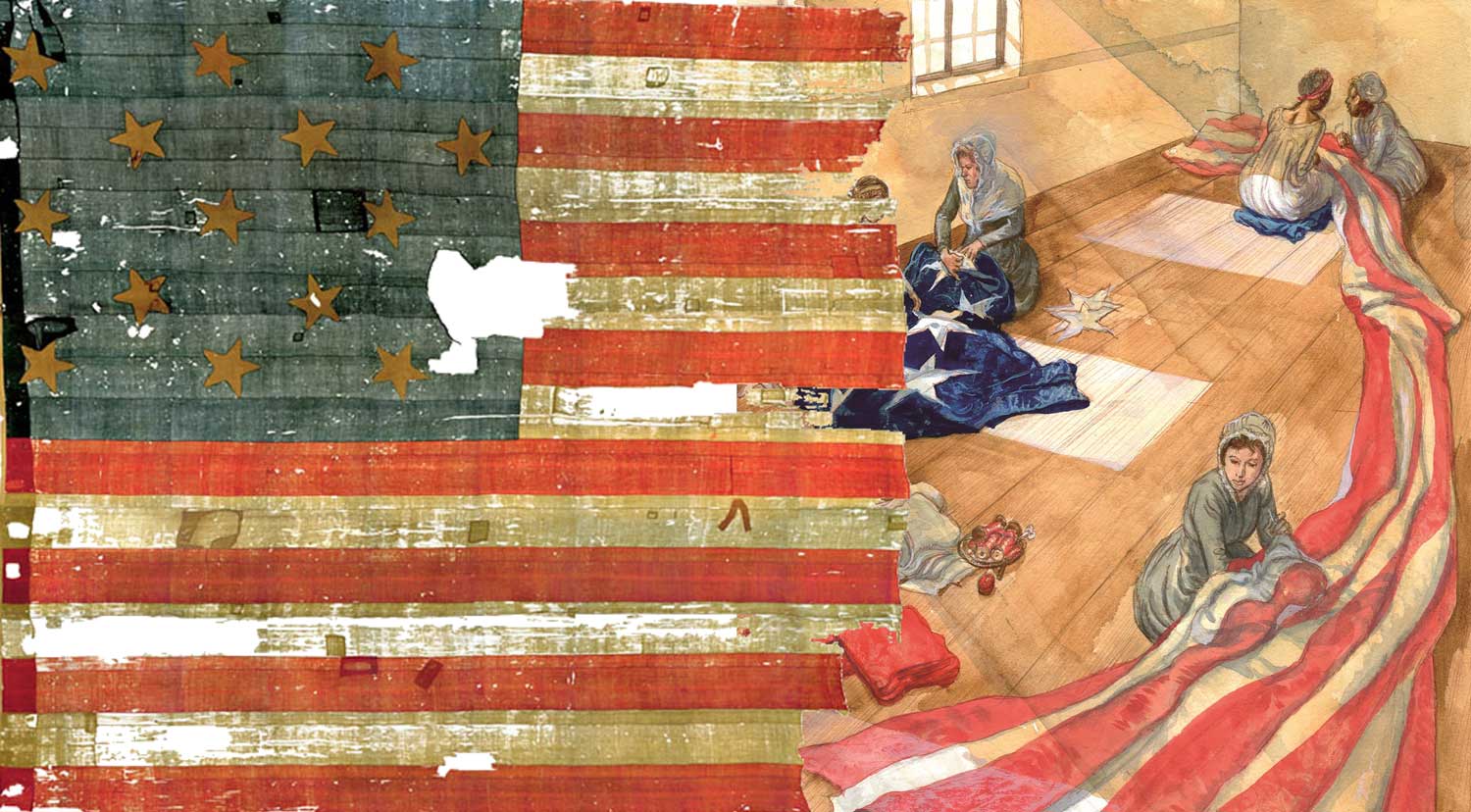No products in the cart.

Do you know the full story of the Star-Spangled Banner Flag, also known as The Great Garrison Flag? U.S. soldiers hoisted the immense flag — complete with 15 stars and stripes — over Fort McHenry in Baltimore on the morning of September 14, 1814 to celebrate a pivotal victory in the War of 1812.
This flag is best known for inspiring Francis Scott Key to write the poem that would ultimately become our national anthem. When Key saw the American flag still flying over Baltimore on September 14, after twenty five hours of bombardment, he penned “Defence of Fort M’Henry.” The first verse of Key’s poem would later be set to music and re-titled “The Star-Spangled Banner” that we know today.
O! say can you see, by the dawn's early light,
What so proudly we hail'd at the twilight's last gleaming,
Whose broad stripes and bright stars through the perilous fight,
O'er the ramparts we watch'd, were so gallantly streaming?
And the rockets' red glare, the bombs bursting in air,
Gave proof through the night that our flag was still there —
O! say, does that star-spangled banner yet wave
O'er the land of the free, and the home of the brave?
From Defence of Fort M'Henry by Francis Scott Key
What you may not know is how the Star-Spangled Banner Flag came to be — and who made it possible. Baltimore flagmaker Mary Pickersgill is credited with designing and sewing the flag. Pickersgill had only six weeks to sew the enormous 30 x 42 foot flag — all by hand. Fort McHenry’s commanding officer, Major George Armistead, said he wanted a flag “so large that the British will have no difficulty in seeing it from a distance.” It was a tremendous feat to produce such a vast flag in so little time. And Pickersgill couldn’t do it alone.
An oil painting by R. McGill Mackall shows Pickersgill sewing the stars on the flag by candlelight — just one of these stars covers her entire lap.

"Placing the Stars on the Flag That Inspired Francis Scott Key to Write Our National Anthem, Claggett's Brewery, Baltimore, 1812-1814" by Robert McGill Mackall
In the image, she is assisted by her niece and daughter, Caroline. Not seen in the painting, however, is her other apprentice, Grace Wisher. Grace was a 13-year-old Black girl, indentured to Pickersgill as a child. And while Grace was instrumental in crafting one of the most beloved emblems in American history, her story is often erased in the Star-Spangled Banner Flag’s re-telling. In recent years, historians and activists have been working to change that.
Today, the Star-Spangled Banner Flag House in Baltimore, where the flag was constructed, is a National Historic Landmark and museum. In 2014, to recognize Grace’s contributions, the museum traced a ghost figure sitting and sewing next to Pickersgill, on the plexiglass over the painting of the flag’s making. Working with Michelle Joan Wilkinson, now a curator at the Smithsonian Institution's National Museum of African American History and Culture, the Flag House designed an exhibition entitled, For Whom It Stands, that explored a diversity of perspectives on the flag’s meaning — and highlighted Grace’s story.
An artist's depiction of the sewing of the Star-Spangled Banner from "In Full Glory Reflected."
Wilkinson told Teen Vogue, “I think it’s important that there’s not a single narrative. There are things we think we know, but there’s more we need to know. And certainly, Grace Wisher’s life and her contributions should not go unknown. It should be acknowledged and presented in our historical displays about this era.”
In 2018, griot and quilter Edna Williams Lawrence visited the Flag House and, upon seeing Grace’s ghostly outline, was moved to make Grace’s story even more visible. Lawrence called the museum and said, “I have a proposal to do a quilt to give Grace Wisher an image.”
This quilt became one of twelve that Lawrence lent to the museum, forming an exhibit, “Fabric Expressions: THE LOST STORY (I AM GRACE WISHER),” which ran for several years. Lawrence went on to sponsor and erect a ceremonial sign on the block next to the house, which reads “Grace Wisher Way.”
“Grace Wisher is a part of the American story,” Lawrence told The Atlanta Journal-Constitution in 2021, as she recounted some of the obstacles she faced in ensuring Grace’s contributions to the flag would be remembered for years to come. Honoring Grace Wisher means acknowledging that she was an indentured servant who also worked alongside enslaved people in the Pickersgill household, as the Star-Spangled Banner flag was being made. This reminds us that the American story is woven together with both pride and pain. Yet, without Grace Wisher, America’s story would be incomplete.
“Black girls and women like Grace have literally stitched themselves into our nation’s history,” historians Daina Berry and Kali Gross write in A Black Women’s History of the United States. Grace Wisher and others like her shaped the fabric of our nation — the flag flies for her, too, just as it flies for you.